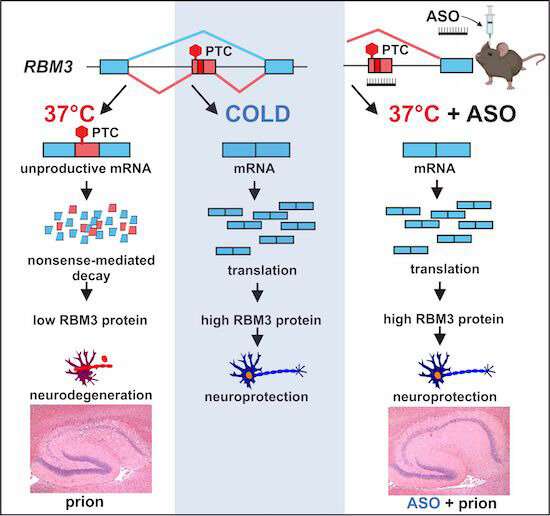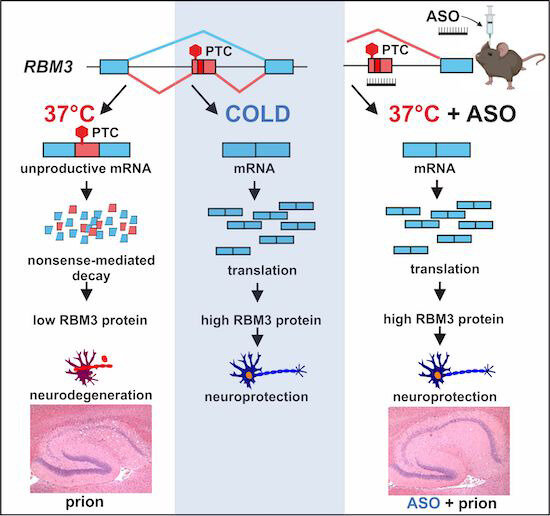
Scientists in Cambridge and Berlin have used a form of gene therapy to increase levels of the so-called “cold shock protein” in the brains of mice, protecting them against the potentially devastating impact of prion disease.
The discovery is a step towards harnessing the protective effects of cooling the brain to treat patients with acute brain injury and even to prevent dementias, such as Alzheimer’s.
When the body cools down significantly, it increases its levels of RBM3, a molecule known as the cold shock protein—a phenomenon first observed in hibernating animals. It is thought that during hibernation, the protein helps protect the brain from damage and allows it to continue to form new connections.
In 2015, Professor Giovanna Mallucci and colleagues showed in mice that RBM3 can protect the brain against damage associated with build-up of misfolded proteins, which can lead to various forms of dementia, such as Alzheimer’s and Parkinson’s disease, and from prion diseases such as Creutzfeldt-Jakob Disease (CJD).
Induced hypothermia is used to treat patients in intensive care units—including newborn babies and traumatic brain injury patients—with the patients placed into a coma and their brains cooled to protect against damage. But this comes with associated risks, such as blood clotting and pneumonia. Could the cold shock protein be harnessed to treat patients without having to cool the body, offering a safer treatment for acute brain injury or a way of protecting the brain against dementia?
In research published in EMBO Molecular Medicine, scientists at the UK Dementia Research Institute, University of Cambridge, and the Institute of Chemistry and Biochemistry, Freie Universität Berlin, studied whether a form of gene therapy known as antisense oligonucleotides (ASOs) could increase levels of the cold shock protein in the brains of mice—and hence protect them.
The team examined the gene that codes for production of the cold shock protein and found that it contains a key element which under normal conditions prevents its expression. Removing, or “dialing down” this element using an ASO, results in a long-lasting boost to production of RBM3.
To test whether this approach could protect the brain, the researchers used mice infected with prions. Some of these mice were injected with a single dose of the ASO three weeks later, while the others were given a control treatment.
Twelve weeks after being administered the prions, those mice that had received the control treatment succumbed to prion disease and showed extensive loss of neurons in the hippocampus, an area of the brain important for memory.
The story was very different for the mice that had received the ASO. At the same time as the other mice were succumbing to prion disease, the ASO-treated mice had levels of RBM3 twice as high as in the other mice. Seven of the eight ASO-treated mice showed extensive preservation of neurons in the hippocampus.
Professor Giovanna Mallucci, who led the work while at the UK Dementia Research Institute at the University of Cambridge, said, “Essentially, the cold shock protein enables the brain to protect itself—in this case, against the damage to nerve cells in the brain during prion disease. Remarkably, we showed that just a single injection with the ASO was sufficient to provide long-lasting protection for these mice, preventing the inevitable progression of neurodegeneration.”
Professor Florian Heyd from Freie Universität Berlin added, “This approach offers the prospect of being able to protect against diseases such as Alzheimer’s and Parkinson’s disease, for which we have no reliable preventative treatments.
“We are still a long way off this stage as our work was in mice, but if we can safely use ASOs to boost production of the cold shock protein in humans, it might be possible to prevent dementia. We are already seeing ASOs being used to successfully treat spinal muscular atrophy and they have recently been licensed to treat motor neuron disease.”
If the findings can be replicated in humans, this approach could have major implications for the treatment of patients beyond neurodegeneration. These include acute brain injury from newborn babies with hypoxia through protecting the brain in heart surgery, stroke and head injury in adults who would otherwise be treated by therapeutic hypothermia.
More information:
Marco Preußner et al, ASO targeting RBM3 temperature‐controlled poison exon splicing prevents neurodegeneration in vivo, EMBO Molecular Medicine (2023). DOI: 10.15252/emmm.202217157
Journal information:
EMBO Molecular Medicine
Source: Read Full Article
